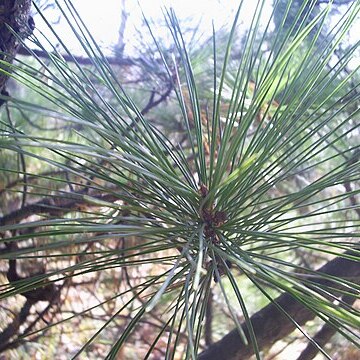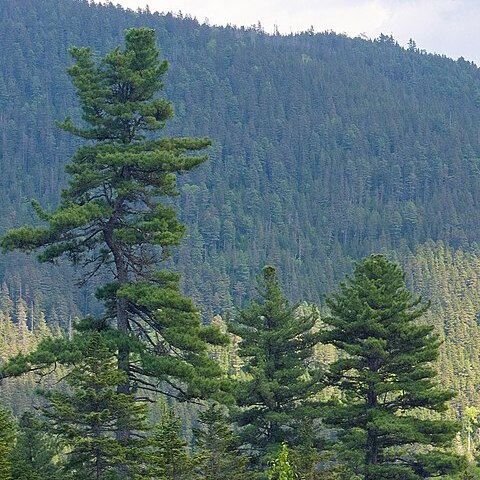Trees to 50 m tall; trunk to 1 m d.b.h.; bark gray-brown or gray, fissured longitudinally into irregularly oblong plates, inner bark red-brown; branchlets densely red-brown, occasionally yellow pubescent; winter buds reddish brown, oblong-ovoid, slightly resinous. Needles 5 per bundle, dark green, straight, almost triangular in cross section, 6-12 cm, stomatal lines 6-8 along each abaxial surface, blue-gray, vascular bundle 1, resin canals 3, median, base with sheath shed, margin serrulate. Seed cones solitary or several clustered near apex of 1st-year branchlets, erect, pedunculate (peduncle 1-1.5 cm), conical-ovoid or ovoid-oblong, 9-14 × 6-8 cm, indehiscent or slightly dehiscent at maturity, with seeds exposed but not shed. Seed scales reflexed at apex. Seeds triangular-obovoid, 1.2-1.6 cm, wingless.
More
A tree. It grows to 50 m tall. The trunk is 1 m across. The bark is grey-brown. It is cracked along its length into irregular plates. The young branches are red-brown. There are 5 needles per bundle. They are dark green and straight. The are triangle shape in cross section. They are 6-12 cm long. The seed cones can occur singly or as several clustered together near the end of a first year branch. They are erect and have a stalk 1-1.5 cm long. The cone is oval to oblong and 9-14 cm long by 6-8 cm wide. The seeds are exposed but not shed at maturity. The seeds are oval or triangle shaped and 1.2-1.6 cm across. They do not have wings.
Mixed coniferous and mixed conifer-deciduous forests on dry mountain slopes, especially those facing north; at elevations from 200-600 metres in the north of its range, ascending in more southerly latitudes from 500-2,500 metres.
More
It is a temperate plant. It grows in the mountains in N China between 200-1800 m altitude. It grows naturally in river valleys and on low mountain slopes. It is very hardy. It suits hardiness zones 3-9. Arboretum Tasmania.
The seeds are eaten raw or roasted. They are used in candies, sweet cakes, rice desserts, and savoury dishes. The pollen is used in cookies. The green cones are used for making wine. The seeds are finely ground and the powder sprinkled on food.
Can be grown by cuttings, graftings or seedlings. Seeds needs soaking.



